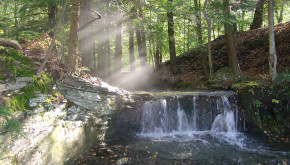
Guest post by Bethany Keene
“Eventually all things merge into one, and a river runs through it.” – Norman Maclean
Land and water. We always talk about them together, but why?
The reason is simple: to care for the land is to care for the water. In fact, it’s that very idea that established the Delaware Highlands Conservancy. When the Conservancy’s founder Barbara Yeaman first canoed the Upper Delaware River in the 1980s, she was shocked at what she found. She was visiting from Maryland, where increasing development was having a major impact on the region’s rivers—but this water looked very different.
“What a change from the Potomac and Monocacy rivers that seldom ran clear anymore! Paddling the Upper Delaware revealed all kinds of fish and plants growing in the clear water under our paddles. I loved this new place, and was drawn to live here, but quickly realized that this river too could change,” Barbara explains.
She knew that to prevent the Delaware from becoming similarly polluted, it was necessary to protect the land around it. Forests are the best water filters around—something that’s easy to see for yourself if you take a look at a forested stream after a rainfall compared to a stream in a more developed area. Steams near developed areas will often turn brown after a storm because there is nothing to slow and filter the rainfall, or to prevent runoff from nearby surfaces. But rainfall in forested regions is captured by the trees and filtered through the soil and the roots before slowly making its way back into the water, so the stream continues to run clear.
Of course, everyone knows that clean, clear drinking water is a necessity for healthy people and a healthy world. But it’s a very limited resource—only 2.5 percent of the world’s water is fresh (not salt water), and we’re only able to access one percent of it. 750 million people (or, more than twice the population of the United States), already lack access to clean drinking water—a number that is only continuing to rise. But in the Upper Delaware River region, we have the increasingly rare opportunity to protect our water before it becomes polluted.
To care for the land means to care for the water. And to care for the water means to care for our health, now and for generations to come. To care for the water means to care for the wildlife that relies on it.
Whether or not you own land near a river or stream, you can take steps to ensure that our water stays healthy and clean—for people and for wildlife.
· Never pour anything onto the ground or into a stream that you wouldn’t drink.
· Make sure septic systems are in good working order.
· Help your stream maintain its buffer zone—also known as a “riparian buffer”—which is the area of vegetation that separates the stream from development, whether a manicured lawn or a parking lot. Instead of mowing right to the edge, leave that vegetation where it is. It helps reduce runoff—which means sediment and chemicals won’t end up in the stream—and provides important shade and wildlife habitat.
· Don’t divert or change the course of a stream.
· You know not to dump trash in a stream, but don’t put organic materials like leaves or grass clippings in there either, as they reduce the oxygen content. A better idea is to start a compost pile for your yard and kitchen scraps.
· Consider installing a rain barrel under a downspout, which captures runoff from your roof that can then be used to water your garden.
· If you do own forestland, you may want to work with a forester to develop a forest management plan and implement good forest stewardship practices. You may also choose to permanently conserve your land with a land trust like the Delaware Highlands Conservancy.
The most important thing to remember is that what you do to the land, you do to the water.And what you do to the water, you do to everything you drink. One thing is clear—if we want to keep our drinking water clean, we need to take a close look at the changes we are making to the land around us, and ensure we are doing all that we can to support a sustainable future.
To learn more about the Delaware Highlands Conservancy’s efforts to protect land and water and to promote sustainable development based on our local farm, forest, and ecotourism economies, or about your options for conserving your own lands, find us on the web at www.DelawareHiglands.org or call 570-226-3164.
The Delaware River Watershed Initiative
Launched in 2014, the Initiative began with a three-year $35 million investment from the William Penn Foundation.
The goal is to accelerate conservation in eight "clusters." The Pocono-Kittatinny Cluster is located in our Upper Delaware River region, and encompasses portions of New York's Catskills and Shawangunk Mountains, New Jersey's Kittatinny Ridge, and Pennsylvania's Pocono Mountains.
The funds from this program are helping the Conservancy improve our outreach to the public about the importance of our forests to protecting water quality, to encourage landowners to take action to protect their land, and to work with local government on actions that will safeguard our water resources.
Also, landowners within the Pocono-Kittatinny Cluster may be eligible for funding to protect their lands with a conservation easement. Learn more by contacting us at [email protected], or at 570-226-3164.

